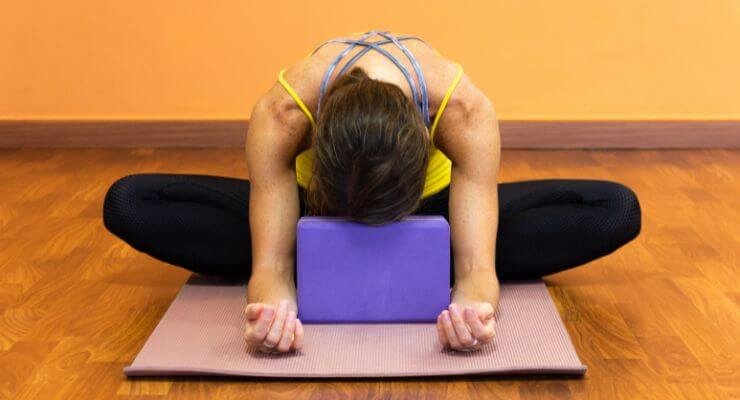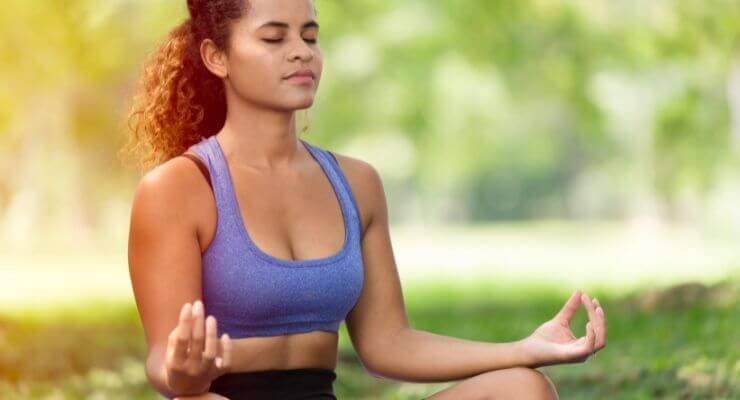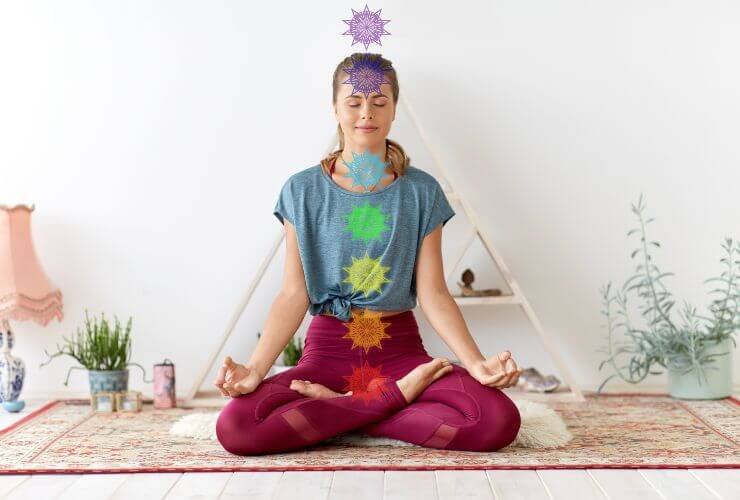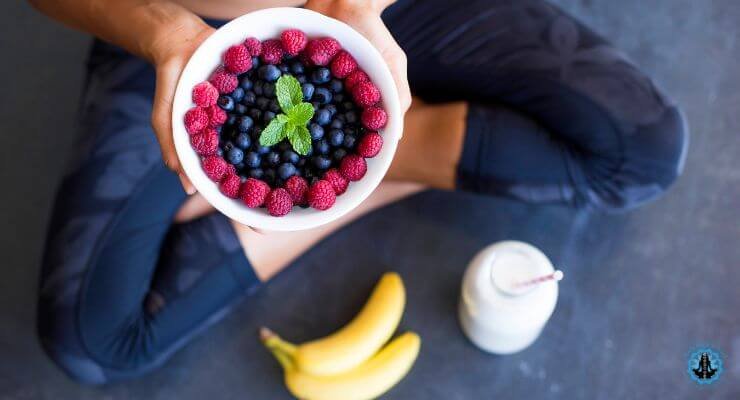Yin Yoga is a slow-paced practice that involves holding poses for an extended period of time, typically 3 to 5 minutes or more. Yin Yoga focuses on stretching and strengthening the connective tissues of the body, such as the ligaments, tendons, and fascia.
Unlike other forms of yoga that are more dynamic and muscular, Yin Yoga is a more meditative practice that allows practitioners to turn inward and tune into both their mind and physical sensations.
The practice is suitable for almost all levels of students and is a perfect complement to the more active styles of yoga.
Yin Yoga generally targets the connective tissues of the hips, pelvis, and lower spine, but can also benefit other parts of the body.
Overall, Yin Yoga is a great way to improve flexibility, reduce stress, and increase overall well-being.
It is a practice that can be beneficial for people of all ages and abilities.
In the following sections, we will explore the benefits, poses, and techniques of Yin Yoga in more detail.
Origin of Yin Yoga
Yin Yoga is a relatively new form of yoga that has gained popularity in recent years.
Although it is considered new, it is rooted in ancient practices of yoga and Chinese medicine.
The founder of Yin Yoga is Paulie Zink, a martial arts expert and Taoist yoga teacher who developed the practice in the late 1970s.
However, it was Paul Grilley and Sarah Powers who popularized Yin Yoga in North America and Europe.
Yin Yoga is based on the concept of Yin and Yang, which are opposing but complementary forces in nature.
Yin represents the passive, receptive, and cooling aspects of nature, while Yang represents the active, dynamic, and warming aspects.
In Yin Yoga, the focus is on the Yin aspect, which involves holding poses for an extended period of time, typically three to five minutes or longer.
The practice of Yin Yoga is rooted in the ancient practice of Hatha Yoga, where poses were held for several minutes to create a deep stretch in the body.
Yin Yoga takes this concept a step further by targeting the connective tissues, such as ligaments, tendons, and fascia, instead of the muscles.
This deeper level of stretching helps to increase flexibility, improve joint mobility, and release tension in the body.
In summary, Yin Yoga is a modern form of yoga that is rooted in ancient practices of yoga and Chinese medicine. It was founded by Paulie Zink, but popularized by Paul Grilley and Sarah Powers. The practice focuses on the Yin aspect of nature, involves holding poses for an extended period of time, and targets the connective tissues in the body.
Principles of Yin Yoga
Yin yoga is a passive, mellow, and meditative style of yoga that involves long holds in various seated and reclined poses to access deeper layers of fascia and a quieting of the mind.
There are three tenets of Yin Yoga: stillness, time, and edge.
Stillness
One of the core principles of Yin Yoga is stillness.
In a Yin Yoga practice, practitioners hold poses for an extended period, typically three to five minutes or longer.
During this time, the body is encouraged to relax and release tension, allowing the practitioner to focus on their breath and inner sensations.
By cultivating stillness, Yin Yoga helps to quiet the mind, reduce stress and anxiety, and promote a sense of inner peace.
Time
Another essential principle of Yin Yoga is time.
In contrast to more dynamic styles of yoga, Yin Yoga poses are held for an extended period, allowing the body to sink deeper into the pose and access deeper layers of fascia and connective tissue.
This extended hold time also allows the body to release tension and stress, promoting a sense of relaxation and calm.
Edge
The final principle of Yin Yoga is edge.
In Yin Yoga, the edge refers to the point where the practitioner feels a deep stretch or sensation in the body, but without pain or discomfort.
Finding this edge is essential in Yin Yoga as it helps to prevent injury and promotes a safe and effective practice.
By finding the edge, the practitioner can work with their body’s natural limits, gradually deepening their practice over time.
In summary, the principles of Yin Yoga include stillness, time, and edge. By cultivating these principles, practitioners can access deeper layers of fascia and connective tissue, promote relaxation and calm, and work with their body’s natural limits to deepen their practice over time.
Benefits of Yin Yoga
Yin Yoga is a practice that targets the deep connective tissues of the body – the ligaments, joints, bones, and deep fascia networks.
Unlike Yang yoga practices, which physically target the superficial muscles, Yin yoga uses gentle, relaxing postures to alleviate tension, enhance breath awareness, and develop mindfulness.
Here are some of the benefits of Yin Yoga:
Physical Benefits
Yin Yoga can help improve flexibility, increase circulation, and reduce the risk of injury.
Holding poses for an extended period of time can help stretch and lengthen rarely-used tissues, such as ligaments, tendons, and fascia.
This can lead to increased joint mobility and range of motion.
Additionally, Yin Yoga can help stimulate the body’s natural healing processes, reducing inflammation and promoting tissue regeneration.
Yin Yoga can also help improve posture and balance.
By targeting the deep connective tissues, Yin Yoga can help strengthen the muscles that support the spine and improve overall alignment.
This can lead to improved posture and balance, reducing the risk of falls and other injuries.
Mental Benefits
Yin Yoga can help reduce stress and anxiety, improve sleep quality, and enhance overall well-being.
Holding poses for an extended period of time can help activate the parasympathetic nervous system, promoting relaxation and reducing stress.
Additionally, Yin Yoga can help develop mindfulness and self-awareness, allowing practitioners to better understand and manage their thoughts and emotions.
Yin Yoga can also help promote a sense of calm and inner peace.
By focusing on the breath and cultivating a sense of stillness, practitioners can develop a deeper connection to themselves and the world around them.
This can lead to a greater sense of purpose and meaning in life.
Overall, Yin Yoga is a gentle, yet powerful practice that can help improve physical and mental well-being. Whether you’re looking to reduce stress, improve flexibility, or enhance overall health, Yin Yoga may be a valuable addition to your wellness routine.
Common Yin Yoga Poses
Yin Yoga is a slow-paced style of yoga that involves holding poses for an extended period, typically 3-5 minutes.
The poses are designed to target the connective tissues of the body, such as the ligaments, fascia, and joints, rather than the muscles.
Here are some common Yin Yoga poses that you might encounter in a Yin Yoga class.
Butterfly Pose
Butterfly Pose, also known as Baddha Konasana, is a seated pose that stretches the inner thighs, groins, and knees. To do this pose, sit on the floor with your legs straight out in front of you. Bend your knees and bring the soles of your feet together, allowing your knees to fall out to the sides. Use your hands to gently press down on your thighs to deepen the stretch. You can also fold forward over your legs to intensify the stretch.
Dragon Pose
Dragon Pose, also known as Lizard Pose, is a hip-opening pose that targets the hips, hamstrings, and quadriceps. To do this pose, start in a low lunge with your right foot forward. Lower your left knee to the ground and walk your right foot out to the right side of your mat. Lower your forearms to the ground and sink your hips down towards the ground. You can also straighten your right leg to deepen the stretch.
Sphinx Pose
Sphinx Pose is a gentle backbend that stretches the spine, chest, and shoulders. To do this pose, lie on your stomach with your elbows under your shoulders and your forearms on the ground. Press down through your forearms to lift your chest off the ground. Keep your shoulders relaxed and your gaze forward. You can also slide your hands forward to deepen the stretch.
These are just a few examples of the many Yin Yoga poses that you might encounter in a Yin Yoga class.
Remember to listen to your body and only go as far as feels comfortable for you.
With regular practice, Yin Yoga can help improve flexibility, reduce stress, and promote relaxation.
How to Practice Yin Yoga
Yin Yoga is a practice that emphasizes stillness and relaxation.
It is a great way to reduce stress, increase flexibility, and improve overall well-being.
Here are some tips on how to practice Yin Yoga effectively:
Setting the Environment
To practice Yin Yoga, it is important to create a comfortable environment that is conducive to relaxation. Here are some tips on how to set up your space:
- Choose a quiet and peaceful location where you will not be disturbed.
- Dim the lights or light candles to create a calming atmosphere.
- Use props such as blankets, bolsters, and blocks to support your body in the poses.
- Wear comfortable clothing that allows you to move freely.
Breathing Techniques
In Yin Yoga, breathing is an essential part of the practice. Here are some breathing techniques that can help you relax and focus:
- Deep breathing: Take slow, deep breaths in through your nose and out through your mouth. Focus on your breath and allow your body to relax with each exhale.
- Ujjayi breath: This is a type of breathing that involves constricting the back of your throat as you inhale and exhale through your nose. It can help you stay focused and calm during your practice.
- Alternate nostril breathing: This technique involves closing one nostril with your finger and breathing in through the other nostril. Then, close the other nostril and exhale through the first nostril. Repeat on the other side. This technique can help balance the body and mind.
By following these tips, you can create a comfortable environment and use breathing techniques to enhance your Yin Yoga practice. Remember to listen to your body and go at your own pace. With regular practice, you can experience the many benefits of Yin Yoga.
Yin Yoga vs Other Yoga Styles
Yin Yoga is a unique style of yoga that is different from other yoga styles in many ways.
Here are some of the key differences between Yin Yoga and other yoga styles:
Duration of Asanas
In Yin Yoga, most poses are held for an extended period, usually between 3 to 10 minutes.
This is in contrast to dynamic forms of yoga like Ashtanga Vinyasa and Vinyasa Flow, where poses are held for 5 to 10 breaths, and practitioners constantly move in and out of poses.
The extended holding of poses in Yin Yoga helps to improve flexibility, increase circulation, and release tension in the body’s connective tissues.
Focus on Connective Tissues
Yin Yoga primarily targets the body’s connective tissues, including ligaments, tendons, and fascia.
Other yoga styles, on the other hand, focus more on the body’s muscles.
The long holds in Yin Yoga help to stretch and stimulate the connective tissues, which are typically more difficult to target with other yoga styles.
Breath and Meditation
Yin Yoga emphasizes the breath and meditation during practice.
Practitioners are encouraged to focus on their breath and be present in the moment, rather than just moving through poses.
This focus on breath and meditation can help to reduce stress and anxiety and improve overall mental health.
Suitable for All Levels
Yin Yoga is suitable for all levels, including beginners.
The long holds in poses allow practitioners to ease into the posture and find a comfortable position.
The practice is also ideal for those dealing with injuries or chronic conditions like arthritis or osteoporosis, as it is a more restorative practice than other forms of exercise.
Overall, Yin Yoga is a unique and beneficial practice that offers many benefits for the body and mind.
Its focus on long holds, connective tissues, breath, and meditation make it a great complement to other yoga styles and a valuable addition to any yoga practice.
Conclusion
Yin Yoga is a gentle form of yoga that targets the deep connective tissues of the body.
It is a slower and more meditative practice that gives the practitioner space to turn inward and tune into both the mind and physical sensations of the body.
This practice is suitable for almost all levels of students and is a perfect complement to the dynamic and muscular (yang) styles of yoga that emphasize internal heat and the lengthening and contracting of muscles.
It generally targets the connective tissues of the hips, pelvis, and lower spine.
The practice involves holding specific passive poses (called yin poses) for an extended time, usually 3 to 10 minutes.
This extended holding of poses helps to stimulate the flow of energy through the body’s meridian system, improving the overall health of the body.
Some practitioners believe that it helps to improve flexibility, increase circulation, and reduce stress and anxiety. Others believe that it can help to improve joint mobility, reduce inflammation, and promote deep relaxation.
While there is no doubt that Yin Yoga has many benefits, it is important to remember that it is just one form of yoga.
Practitioners should always listen to their bodies and practice yoga in a way that feels safe and comfortable for them. With regular practice, Yin Yoga can help to improve overall health and well-being, both physically and mentally.
Frequently Asked Questions
What are the benefits of practicing Yin Yoga?
Yin Yoga has many benefits, including increased flexibility, reduced stress, improved circulation, and better joint mobility. It can also help to calm the mind and improve overall well-being. Additionally, Yin Yoga can be a great complement to more active forms of exercise, such as running or weightlifting.
How does Yin Yoga differ from other forms of yoga?
Yin Yoga is different from other forms of yoga in that it involves holding poses for longer periods of time, typically 3-5 minutes or more. This allows for a deeper stretch and access to the connective tissues in the body. Yin Yoga is also a more meditative practice, with a focus on mindfulness and stillness.
Is Yin Yoga suitable for beginners?
Yes, Yin Yoga can be a great practice for beginners. It is a gentle and slow-paced practice that can be adapted to suit individual needs and abilities. However, it is important to communicate with the teacher and let them know about any injuries or limitations.
What is the history of Yin Yoga?
Yin Yoga was developed in the 1970s by Paulie Zink, who combined elements of Taoist yoga and martial arts. It was further popularized in the 1980s by Paul Grilley and Sarah Powers, who brought the practice to the West and developed their own unique approaches.
What can I expect in a Yin Yoga class?
In a Yin Yoga class, you can expect to hold poses for longer periods of time, typically 3-5 minutes or more. The teacher may also incorporate props, such as blocks or blankets, to help support the body in the poses. The practice is typically done in a quiet and meditative environment, with a focus on mindfulness and stillness.
Can Yin Yoga help tone my body?
While Yin Yoga is not specifically designed to tone the body, it can help to improve flexibility and joint mobility, which can contribute to overall physical health and well-being. Additionally, Yin Yoga can be a great complement to more active forms of exercise, such as running or weightlifting.






Pingback: Yin Yoga: Mastering the Art of Deep Stretch and Inner Peace - YOGMAY